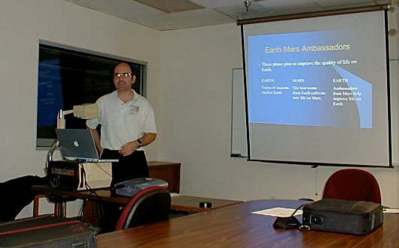






Editor: Kris Cerone
Cerritos Teacher Visits Mars Via Utah
By Steve Bartlett
High school science teacher and space educator Phil Turek described his adventures at the Mars Desert Research Station to an OASIS audience on March 15. Turek, along with a multi-national crew of scientists and engineers, simulated work at a remote Mars base at the Mars Society's research facility in the Utah desert in the fall of 2002. His team experienced firsthand many of the satisfactions and difficulties a crew on Mars might encounter as they explore the Red Planet.
 |
| Phil Turek presenting the Earth Mars Ambassadors project as part of his talk. Photo courtesy of Steve Bartlett. |
The Desert Research Station, located in a remote area of the state well away from civilized comforts and amenities, is designed to closely simulate the living and working conditions of a crew on Mars. It consists of a five-meter diameter habitation module, an airlock, and a "green hab" module developed by the University of Maryland for recycling wastewater. A portable generator provides all electrical power. The Desert Research Station is patterned after the Mars Flashline Station facility on Devon Island in the Canadian Arctic.
Turek, an instructor at Cerritos High School, discussed the living conditions at the remote site. His crew lived in close quarters with one another during the two-week simulation, performing geological and biological research, collecting dinosaur fossils from the nearby area, operating the green hab wastewater processing equipment, and exploring the area around the base site. All communications with the outside world were via satellite link.
The crewmembers had to wear simulated spacesuits whenever they left the habitation module. These suits included heating, cooling and ventilation systems; radios to allow communications between crew members; and tool holsters and carriers for performing useful work outside. All excursions outside the habitation module required a forty-minute preparation in the Airlock to simulate the preparation time required for an actual surface excursion on Mars.
To explore areas further away than walking distance from the base, the crew were provided with three all-terrain vehicles (ATV's.) One of the ATV's became stuck in a box canyon during one excursion, as might happen with a rover on the surface of Mars, and the crew had to come up with a way to free it an allow it to return safely to the base.
Turek was a member of Crew 8 of the Desert Station. The six crewmembers came from California, New York, Houston, Finland, and Canada. They included a planetary scientist, a retired NASA operations engineer, a geologist, a designer who builds props and stages for Broadway shows, a biomedical engineer, and an educator (Turek.)
He amused the audience with tales of the unofficial crew mascot, Rustle the field mouse, which managed to make his way into the Hab module and do some exploring of his own. In addition, the crew had to deal with the occasional scorpion.
A few days into the simulation, the biomedical engineer had to leave the simulation due to a personal emergency. This left no one to support the green hab module. As might happen on an actual Mars mission in the event of a crew incapacitation or death, the rest of the crew had to fill in for the lost capability. It became Turek's responsibility to keep the green hab operating.
One of the most satisfying jobs the crew performed was putting plants around the campsite as part of the "greening of Mars," as might happen in a terraforming operation.
During the mission, the Internet satellite link connecting the station to the outside world went down. This prevented the crew from exchanging emails with students back in the classroom and severely limited their contact with the Station's home base.
Turek mentioned that he has applied to the Educator Astronaut program, wherein 3-6 teachers will become full-time astronauts. He concluded his talk by providing the audience with some perspective on teaching in general and on teaching science in a high school in particular.
The slides from Phil's talk are online (13.2MB).
Copyright © 1998-2003 Organization for the Advancement of Space Industrialization and Settlement. All Rights Reserved.